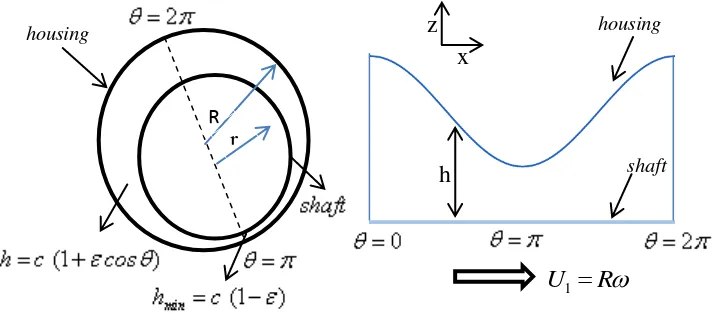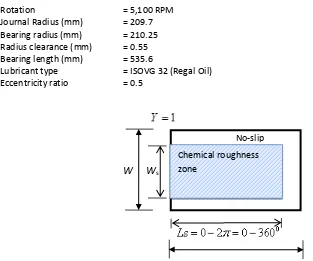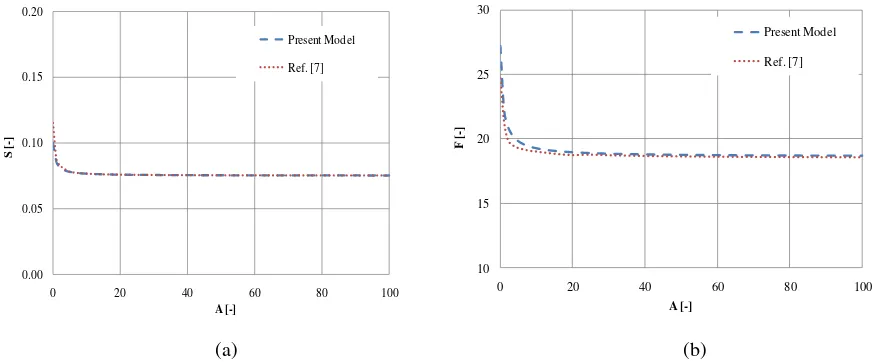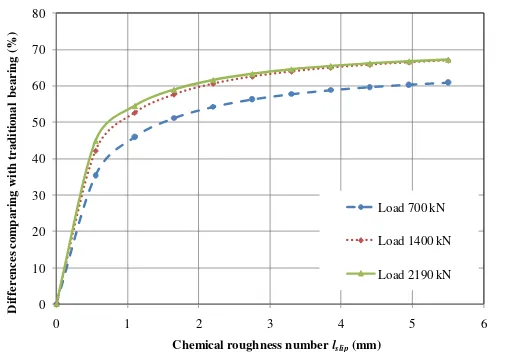Numerical Analysis of a Journal Bearing with Chemical
Roughness
Mohammad Tauviqirrahman a,b, Muchammad a, Jamari b, and Dik J. Schippera
a
Laboratory for Surface Technology and Tribology, Faculty of Engineering Technology, University of Twente
Drienerloolaan 5, Postbus 217, 7500 AE, Enschede, The Netherlands, Phone: +31 53 489 2469, Fax: +31 53 489 4784
b
Department of Mechanical Engineering, University of Diponegoro
Jl. Prof. Soedharto, Tembalang, Semarang, Indonesia, Phone: +62 24-7460059 ext. 115 E-mail : [email protected]
Abstract :
In this paper, performances of an oil-lubricated journal bearing are investigated with special attention paid to slip occurrence. The chemical roughness at which slip occurs is introduced. The slip length model which is a theoretical scheme for taking the slip occurrence into hydrodynamic lubrication theory is applied to the analyses by a finite volume treatment of the Reynolds equation that deals with the geometry of a journal bearing. The calculated results are compared with other literature under certain eccentric state, and verified in terms of Sommerfeld number and the friction force. The study shows that the presence of judicious chemical roughness in deterministic way can result in a significant improvement in decreasing power loss of the bearing performance.
Keywords: chemical roughness, finite volume method, journal bearing, lubrication, slip
1. Introduction
The behavior of the journal bearing is determined by the fluid flow and the boundary conditions at the interfaces. When the classical Reynolds equation is derived, it is usually assumed that the liquid molecules adjacent to the solid are stationary relative to the solid. However, recently, researchers have observed the occurrence of slip using specially prepared surfaces [1-3]. Slip can occur on the surface containing chemical roughness. Such surface can be obtained by modification of their roughness and surface energy. It is then necessary to make these surfaces hydrophobic by grafting or deposition of hydrophobic compounds.
The chemical roughness, which is used to qualify heterogeneities in slip conditions, is introduced deliberately on a surface in a wide range of applications for the mechanical components such as journal bearing. Such roughness can be engineered by employing (super)hydrophobic surfaces which were originally inspired by the unique water-repellent properties of the lotus leaf with the help of micro-fabrication. Chemical roughness is claiming progressively more attention and is expected to be an important component in future bearing structure design as demonstrated by the authors [4-10]. By means of the new technology, i.e. chemical etching, it is now possible to produce controlled roughness zone on journal bearing surfaces to improve the overall tribological performance including the friction reduction, the reliability improvement, the severity conditions increase, and the energy consumption lowering.
Spikes [4-5] derived the extended Reynolds equation for half-wetted bearings and analyzed the influence of wall slip on the hydrodynamic properties of a slider bearing and found that wall slip reduces both of the fluid load support and the friction drag. Under very low load and very smooth sliding microscale contact applications as those in micro-electro-mechanical systems-(MEMS), the half-wetted bearing has the potential for improving the bearing design by controlling the slip at the non-wetted surface [5]. Salant and Fortier [6], and Fortier and Salant
However, most of the current literatures investigating the phenomena of slip boundary in the hydrodynamic lubrication employed a non-conversing mass model, i.e. Reynolds cavitation model. Thus, their research results are still questionable. As discussed by Bayada and Meurisse [11], the performance of sliding contact containing chemical roughness was strongly dependent on the cavitation model. Therefore, it is preferred to take into account mass-conserving cavitation model when investigating the chemical roughness effect.
In the present study, an improvement in the tribological performance of journal bearings is examined based on the chemical roughness phenomenon including mass-conserving cavitation model. In the roughness region, based on the slip length model, it is assumed that the magnitude of the shear stress is proportional to the slip speed [4]. The extended form of the Reynolds equation is derived in which the slip is allowed to occur on the bearing surface. The effects of the chemical roughness parameters on the bearing characteristics are discussed. The pattern of the chemical roughness regions on the bearing surface will lead to an improved bearing performance characteristic.
2. Material and Methods
The problem of the lubrication of journal bearings with finite length is defined in this work as the calculation of the pressure distribution of the Newtonian lubricant that is assumed to flow under laminar, isoviscous, and isothermal conditions in between the rotating journal and the static bearing. The fluid film lubrication between shaft and housing surfaces of the journal bearing can be schematically illustrated in Figure 1.
Figure 1. (a) Schematic representation of journal bearing; (b) film thickness profile
The shaft surface is designed as the no-slip surface and has a rotational speed, whereas the housing surface containing the chemical roughness is fixed. Such a lubrication system can be described with solving the extended Reynolds equation as follows [9]:
The slip length model used for modeling the chemical roughness surface is adopted. In the present study, the chemical roughness zone is engineered at the leading edge of the contact (see Figure 2). The geometry of that zone has a rectangular shape (Ws x Ls). The parameters of journal bearing used in the simulation are as follows:
Rotation = 5,100 RPM Journal Radius (mm) = 209.7 Bearing radius (mm) = 210.25 Radius clearance (mm) = 0.55 Bearing length (mm) = 535.6
Lubricant type = ISOVG 32 (Regal Oil) Eccentricity ratio = 0.5
Figure 2. Schematic representation of the chemical roughness zone (Ws x Ls) on the housing surface. W x L are the width and length of the contact, respectively.
An important consideration in the model for the journal bearing is cavitation of the lubricant film. The
eari g s o ergi g-diverging film thickness profile creates two distinct regions: a liquid region and a cavitation region. Within the cavitation region, the lubricant exists as a two phase mixture. In the present study, for cavitation region, the conservative model as discussed by Refs. [7, 12] is adopted. It can be noted that the surrounding operation pressure pa of the journal bearing is set to atmospheric pressure.
In this work the extended Reynolds equation (Eq. 1) is solved numerically using finite difference equations obtained by means of the micro-control volume approach [13]. The entire computed domain is assumed as a full fluid lubrication. By employing the discretization scheme, the computed domain is divided into a number of control volumes using a grid with uniform mesh size. Those equations are solved using the alternating direction implicit method (ADI) with the tridiagonal matrix algorithm (TDMA), and with a mesh size of 51x51 nodes, obtained from a mesh refinement study.
3. Result and Discussion.
Computations have been made for journal bearing containing chemical roughness for three different applied loads: 700 N, 1400 N and 2,190 N. However, firstly, the study is conducted in order to validate the developed mathematical model and the numerical method. It assures that the mathematical model and numerical method used can be employed for solving other hydrodynamic characteristics. Secondly, the study will be extended to explore the effect of parameters of the chemical roughness such as slip length and length of the zone on power loss. The comparison between the modified journal bearing containing the chemical roughness and the traditional one is conducted in order to describe the benefit of the use of chemical roughness quantitatively. The difference is computed to be
traditional bearing value modified bearing value
Difference (%) 100%
traditional bearing value x
Chemical roughness zone
No-slip
3.1. Validation of the computational results
The chemical roughness model presented here is validated with the numerical results of Fortier and Salant
[7]. The results in this section will be presented in the non-dimensional form. The modified journal bearing containing the chemical roughness is considered so that the roughness area covers only at certain rectangular zone (Ws x Ls) in the inlet as indicated in Figure 2. The geometry of chemical roughness zone having a dimension of 0.7W x 0.5L is employed. It is assumed that the contact length L is set equal to the contact width W. If c is the radial clearance, the slip phenomenon which occurs on the chemical roughness zone is characterised by the dimensionless slip coefficient A = /c , which is related to the slip length lslip = Ac = . The parameters of
tribological performances such as Sommerfeld number S, dimensionless friction force F are investigated with respect to the dimensionless slip coefficient A, as presented in Figure 3.
Based on Figure 3, it can be concluded that the present model is a good agreement with what presented in Ref [7]. It also indicates that the numerical method used is valid for analyzing the journal bearing. Thus, the scope of analysis of modified journal bearing can be extended to explore other parameters in relation to the application of journal bearing.
Figure 3. Effect of dimensionless chemical roughness (slip) coefficient A on (a) Sommerfeld number S, and (b) dimensionless friction force F
3.2. Effect of the parameters of roughness zone
As discussed in the previous section, the chemical roughness can be engineered on the stationary surface, i.e. the housing surface of the journal bearing with a number of possibilities of the roughness zone geometry. Therefore, computations have been made for simulating the variations of parameters of roughness zone such as length of the roughness zone Ls and roughness (slip) length lslip. In this section, the parameter of the roughness zone length LS varies from 0 to 360o, whereas the lslip is varied from 0 to 7 mm based on Refs. [7, 9, 10, 12] It should be noted that for all following computations, the width of the roughness zone Ws is kept constant to 0.7W. The power loss which is of interest in this simulation is defined as , see more detail in Ref. [14].
Figure 4 shows the effect of length of the roughness zone Ls of the journal bearing with a continuous zone on the power loss Pl. It is seen that for Ls <180o, an i rease i po er loss differe es is predi ted. Ho e er, a severe decrease occurs and reaches a minimum value at Ls 220o and then rises again at slow rate. It indicates that the chemical roughness is advisable for being employed at the leading edge of the contact with the length of zone smaller than a half of the total length of the contact. This trend also prevails for three loads. However, it should be noted that a care must be considered when a deterministic zone is carried out. This is because an appropriate choice of the dimension of chemical roughness (Ls in this case) can lead to deterioration of performance, i.e. the increase of power loss, and of course, this is unwanted effect.
roughness zone lslip. This is as expected since increasing lslip will decrease the friction. This effect is, of course,
a ted i the perfor a e of jour al eari g. Ho e er, the i rease of differe es is ot i flue ed a y ore y
lslip when lslip is larger than 5 mm.
0
Figure 4. Effect of the length of the chemical roughness zone Ls on power loss Pl. All profiles are calculated for slip length lslip = 5 mm.
Figure 5. Effect of the chemical roughness length lslip on power loss Pl. All profiles are calculated for length of chemical roughness zone 180o.
4. Conclusion
In this work, cases of journal bearing with chemical roughness on the stationary surface were considered. The extended Reynolds equation was proposed. The numerical method developed is also validated and in a good agreement with published literature. The parameters of the chemical roughness were investigated, such as slip length, and length of slip zone with respect to the tribological performance. Results show thst in deterministic way ( 180o
s
Nomenclatures
c radial clearance e eccentricity f Friction force g Load support h film thickness
hmin minimum film thickness lslip chemical roughness (slip) length L bearing length
Ls roughness zone length pa atmospheric pressure Pl power loss, GR
R housing radius r journal radius U sliding velocity W bearing width Ws roughness zone width
slip coefficient
dynamic viscosity
circumferential coordinate
radial velocity
Dimensionless parameters
A dimensionless slip coefficient, /c F dimensionless friction force, 2 /f cRpa
G dimensionless load support, gpa /R2
S Sommerfeld number, W/ 6RG
eccentricity ratio, e/c
dimensionless speed, (6/pa)( / )R c 2
References
[1] Craig VSJ, Neto C, Williams DRM. 2001. Shear-Dependent Boundary Slip In An Aqueous Newtonian Liquid. Physical Review Letters 87 : 054504.
[2] Zhu Y, Granick S. 2001. Rate-Dependent Slip of Newtonian Liquid At Smooth Surface. Physical Review Letters 87 : 096105. [3] Zhu Y, Granick S. 2002. Limits of The Hydrodynamic No-Slip Boundary Condition. Physical Review Letters 88 : 106102. [4] Spikes HA. 2003. The Half-Wetted Bearing. Part 1: Extended Reynolds Equation. Proceedings of the Institution of
Mechanical Engineers, Part J: Journal of Engineering Tribology 217 : 1–14.
[5] Spikes HA. 2003. The Half-Wetted Bearing. Part 2: Potential Application In Low Load Contacts. Proceedings of the Institution of Mechanical Engineers, Part J: Journal of Engineering Tribology 217 : 15–26.
[6] Salant RF, Fortier AE. 2004. Numerical Analysis of A Slider Bearing With A Heterogeneous Slip/No-Slip Surface. Tribology Transaction 47 : 328–34.
[7] Fortier AE, Salant RF. 2005. Numerical Analysis of A Journal Bearing With A Heterogeneous Slip/No-Slip Surface. ASME Journal of Tribology 127(4) : 820-5.
[8] Ma G.J, Wu CW, Zhou Z. 2007. Wall Slip and Hydrodynamics of Two-Dimensional Journal Bearing. Tribology International 40 : 1056–1066.
[9] Tauviqirrahman M, Ismail R., Jamari J, Schipper DJ. 2011. Effect of Boundary Slip on The Load Support in A Lubricated Sliding Contact. AIP Conference Proceeding 1415 : 51–54. doi: 10.1063/1.3667218.
[10] Wang LL, Lu CH, Wang M, Fu WX. 2012. The Numerical Analysis of The Radial Sleeve Bearing With Combined Surface Slip. Tribology International 47 : 100–104.
[11] Bayada G, Meurisse MH. 2009. Impact of The Cavitation Model on The Theoretical Performance of Heterogeneous Slip/No-Slip Engineered Contacts In Hydrodynamic Conditions. Proceedings of the Institution of Mechanical Engineers, Part J: Journal of Engineering Tribology 223 : 371–81.
[12] Patankar SV. 1980. Numerical heat transfer and fluid flow. Taylor & Francis, Levittown.
[13] Fatu A, Hajjam M, Bonneau D. 2005. Analysis of Non-Newtonian and Piezoviscous Effects In Dynamically Loaded Connecting-Rod Bearings. Proceedings of the Institution of Mechanical Engineers, Part J: Journal of Engineering Tribology 219 : 209–224.



